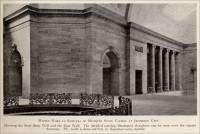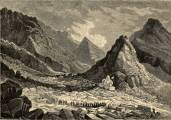
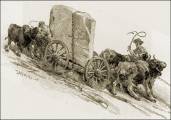

“Marble Work in the Missouri Capitol”
Article from
Stone: An Illustrated Magazine,
Vol. XXXVIII, No. 7, July 1917, pp. 366-367, 369.
“Although the United States is one of the youngest among the brotherhood of nations it has already taken its place on equal terms with the few great leaders, with those lands that are the heritors of many centuries of civilization. The progress of the United States in population, wealth, and all material things has been the wonder of the entire world. If our growth had been along these lines alone there would be little cause for pride, because the bounties of our virgin land would account for much of it. But along with our material progress there has been a steady spiritual growth. We can hold our own in science, in literature, in art, and in architecture. Indeed, there are not lacking frank foreign critics who declare that we have surpassed many of the European countries in our architectural achievements. A proud place in any architectural history must be given to hundreds of our public buildings, not alone in our old cities, but in the young and vigorous commonwealth of the West. The National Government has done much with its Federal buildings, but the states and cities also have done their part. We have more than a score of state capitol buildings that are worthy of their praise. It would be difficult to overestimate the importance of these structures in cultivating public taste. Their influence is felt in every form of local domestic and business architecture.
“While there have been a few scandals in our public buildings – and every country has these – most of our monumental edifices are honestly built and are of the choicest materials available. The exteriors are of finely-wrought stone and the interiors are in beautiful marbles. All of this makes for permanence. But to understand fully all that has been gained in the use of this choicest of Nature’s material for interior finish, we need only contrast our marble and stone corridors and stairways with the plaster and woodwork of a former generation.
“Last month we described and illustrated the exterior of one of the most notable recent public buildings, the Missouri State Capitol at Jefferson City. The architectural features of the interior are fully worthy of their setting. The Missouri Legislature, in making appropriations for the new capitol building, enacted into the law a provision that the native materials of the state should be used as largely as possible in the construction of the building. In many instances this might be an unfortunate proceeding if the beauty and permanence of the structure were to be preserved but Missouri was fortunate in having suitable material for a monumental building. As was explained last month, the exterior walls are of Ozark Gray marble, quarried at Carthage, Mo. The interior finish is in Napoleon Gray marble from the quarries of the Phenix Marble Company, at Phenix, Mo. The architects, Messrs. Tracy and Swartout, of New York, provided a classical design, with a huge dome and surmounting lantern, for the exterior. The great columns on the front and rear porticoes and in the wings have composite capitals. In the interior, however, the Ionic style was followed, yielding a striking effect of dignity and beauty. There are enough enrichments in the way of carved and moulded courses to do away with any sense of plainness in the wall spaces, and yet the ornamentation has been used with admirable restraint. The accompanying illustrations give a better idea of what the architects were able to accomplish by wise design and choice material than any words of description. The marble work is on the Legislative Floor of the capitol. It consists of eight free-standing columns of the State Stairs, two free-standing columns in the Rotunda, all the coursed ashlar of the walls of the side gallery of the State Stairs from the floor to the entablature, the jambs and heads of openings, the entire side walls of the Rotunda from the floor to the entablature, including carved panels, archivolts, keyblocks, pilasters, piers, cornice and balustrade, including cross gallery at third floor level of the Rotunda and Legislative Library. The marble was also used on the side walls of the Domed Lobbies and adjacent corridors, the small lobby with niche at head of State Stairs, the cornice-architrave around the galleries at each side of the State Stairs, the cornice of the Rotunda, the arhivolts in main arches in the Rotunda, including the flat band forming a panel around the coffers in the soffits of the arches. The wall surfaces of the House of Representatives, including the moulded base door trim, also the railing at East Gallery and Press Gallery, are of the Napoleon Gray marble, as well as the side walls of the Senate, including the door trim and jambs and the wainscot and trim in the large House Lounging Room.
| Marble Work in the Missouri State Capitol. Bridge between the Rotunda and Library, executed entirely in Napoleon Gray marble from Phenix, Mo. Architects: Tracy & Swartout, New York. (pp. 366) | 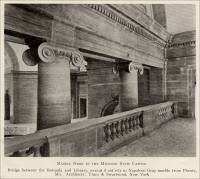 |
| A Carved Panel Over a Doorhead. Detail of Carving on the East Wall of the Rotunda in the Missouri State Capitol at Jefferson City, Mo. Architects: Tracy and Swartout, New York. (pp. 367) | 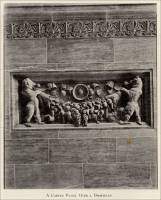 |
“Most of the ashlar in the interior finish is in thin stock, that is, about 2 inches in thickness, excepting at the heads. As can be seen from the illustrations, this gives a very massive appearance and enabled the Commissioners to use marble throughout within the appropriation allowed. The finish is honed and all of the material is set on the natural bed. It is the average run of the quarry and yields an appearance of figured or watered satin. This can be seen even through the medium of the photographs. The carved panels are particularly effective and beautiful and are cut with great delicacy. The Rotunda is a veritable picture gallery in marble. No matter which way the eye turns the architecture is such that the arches and domes weave into space with the most pleasing effect. The treatment of the individual arches is so varied that the eye never tires. The blocks for the columns ran from 8 feet to 10 feet in length, by 4 feet square. The blocks for the lintels were furnished 14 feet long by 4 feet by 4 efet (sic) square. The setting of the work is artistic, the entire job being pointed on white cement.
“It is certain that the Missouri State Capitol will take its place among the notable monumental structures of this country. It is a matter of pride that both the structural and decorative material was the product of American quarries. Such buildings as these are proof that we are no longer dependent upon the old world for our architectural materials. Our stone and marble equals any now on the market.
Commercial use of material within this site is strictly prohibited. It is not to be captured, reworked, and placed inside another web site ©. All rights reserved. Peggy B. and George (Pat) Perazzo.
